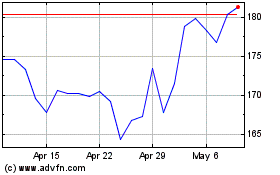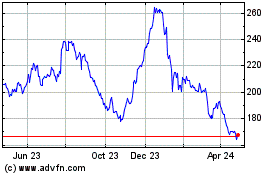By Andy Pasztor and Andrew Tangel
Federal investigators and lawmakers are asking the same question
about Boeing Co.'s 737 MAX jet: Did U.S. safety regulators
rigorously follow longstanding engineering and design standards in
approving a suspect stall-prevention feature?
Officials from the Justice Department and the Transportation
Department inspector general's office are looking into how Boeing
developed the aircraft, which has been involved in two fatal
crashes within five months. The inspector general's office is also
scrutinizing whether the Federal Aviation Administration took any
shortcuts compromising safety, people familiar with the matter
said. Boeing was eager to complete the design and certification
process as quickly as possible, according to people who were
involved.
Boeing has said the FAA certified the 737 MAX according to
identical requirements and processes for previous airplanes after a
six-year, methodical development.
House and Senate committees are separately gearing up to grill
senior FAA leaders next month about many of the same issues,
focusing on the stall-prevention system, which was created for the
737 MAX but not highlighted in pilot manuals or training.
Canada's transport minister, Marc Garneau, said Monday the
government would conduct its own certification of Boeing's promised
software modification to the stall-prevention system, even if it is
certified by the FAA.
Mr. Garneau also said Canada is reviewing its original decision
in 2017 to allow 737 MAX jets to fly in that country's airspace,
effectively replicating the FAA's safety approval. Canada last week
grounded the plane shortly before it was idled in the U.S.
"We're going to review the validation that we did at that time,"
Mr. Garneau said in Ottawa. "We may not change anything but we've
decided that it's a good idea for us to review" the decision.
Such a move is highly unusual, especially for a close U.S.
air-safety partner such as Canada, because governments world-wide
almost always accept the decision of the country where an aircraft
is manufactured. But as in the unilateral grounding of 737 MAX jets
earlier this month by a host of regulators overseas, the FAA's
influence regarding the MAX fleet has been waning.
The U.S. Transportation Department inquiry has included
questions about the aircraft's design, how training was devised and
whether safety was compromised in favor of business concerns, a
person familiar with the details said.
The FAA said the plane was approved to carry passengers as part
of the agency's "standard certification process," which the agency
said is "well established and (has) consistently produced safe
aircraft." The agency declined to comment on various decisions
regarding specific systems.
The Justice Department and the Transportation Department's
inspector general declined to comment.
A Boeing spokesman on Sunday said the Chicago-based company
wouldn't respond to questions on legal matters or governmental
inquiries. The spokesman didn't respond to requests to comment on
Monday.
As The Wall Street Journal reported earlier, a federal grand
jury in Washington, D.C., issued a broad subpoena dated March 11 to
at least one person involved in the 737 MAX's development, seeking
related documents, including correspondence, emails and other
messages.
Rep. Peter DeFazio of Oregon, the Democratic chairman of the
House Transportation and Infrastructure Committee, said his panel
would delve into how the plane was developed and approved. "We're
going to investigate why retraining was not required," Mr. DeFazio
said in an interview after the FAA grounded the planes last week.
"What kind of pressure was applied or not applied?"
Interviews with former government and industry safety experts,
however, highlight potential areas where analyses of the
stall-prevention system, dubbed MCAS, might have deviated from the
FAA's typical safety-review process.
An important element of the Transportation Department review,
these officials said, is expected to be whether the FAA and Boeing
complied fully with traditional FAA design requirements for systems
that are essential to the safety of an aircraft.
Over the years, the agency has mandated the use of a formal,
structured approach to determine how a specific piece of equipment
or system failure should be categorized and scrutinized.
Under the FAA's process, systems that entail significant hazards
and potential loss of life if they go haywire are generally put
into two categories: those that have an "improbable" risk of
failure and those with an "extremely improbable" risk of
failure.
"Improbable" essentially means the part or system is unlikely to
fail during the lifetime of any individual airplane, according to
FAA documents and industry officials. An "extremely improbable"
failure is deemed so rare that it is unlikely to occur during the
lifetime of an entire fleet of aircraft.
Boeing, these officials said, apparently persuaded the FAA that
MCAS wouldn't have to meet the more-rigorous of those standards,
partly because a misfire could be counteracted by pilots simply
turning off the entire system.
A spokesman for Boeing said: "The FAA considered the final
configuration and operating parameters of MCAS during MAX
certification, and concluded that it met all certification and
regulatory requirements."
The need for MCAS arose as Boeing was creating the MAX, because
its large, fuel-efficient engines jutted forward in a way those on
earlier 737 models hadn't. That shifted the plane's balance,
tipping its nose up and making it tougher to fly in certain
conditions than the 737s that pilots world-wide knew how to handle.
To help pilots manage that difference, Boeing added a powerful new
stall-prevention system.
That solution, the stall-prevention system known as MCAS, was
designed to push the plane's nose down in certain conditions to
avoid the aircraft stalling, a loss of aerodynamic lift that can
result when a plane is climbing too steeply or with too little
power, leading to an uncontrolled plunge. But MCAS is now under
scrutiny after investigators determined pilots in the October crash
of Lion Air Flight 610 battled the system during the 11-minute
flight. U.S. and other authorities grounded the MAX after initial
data from this month's crash of a second jetliner, Ethiopian
Airlines Flight 302, pointed to potential similarities with the
Indonesian accident.
Boeing designed MCAS to rely on data from a single sensor that
measures the angle of the plane's nose, known as the angle of
attack. The idea was that a single sensor, rather than two, would
be simpler, a person familiar with the matter has said, and would
be in line with Boeing's long-held design philosophy of keeping the
pilot at the center of cockpit control.
But Boeing's design of the system puzzled some former employees,
safety experts and regulators. They saw it as a departure from the
company's typical practice of relying on multiple sensors to reduce
the risk of systems misfiring based on erroneous data from a single
faulty sensor.
"It seems odd given Boeing's traditions," said Frank McCormick,
a former Boeing flight-controls engineer who went on to be a
consultant to regulators and manufacturers on matters including how
such systems are designed. "It's not just as conservative as would
have been the norm in the old Boeing."
A Boeing spokesman said "design, development and certification
was consistent with our approach to previous new and derivative
airplane designs."
If the FAA had decided differently, a former regulator and an
industry air-safety expert said, Boeing probably would have been
forced to go with a design for MCAS that relied on two sensors,
instead of just one. An FAA document specifies that the possibility
of a given system failing cannot be designated "extremely
improbable" if it could result from a single faulty compon
An air-safety expert with decades of safety work and
accident-investigation experience criticized the notion that the
person flying the plane could provide the ultimate backstop in case
MCAS malfunctioned, saying: "A pilot only provides a redundant
safeguard if he or she has been properly trained to understand the
system."
Since the Lion Air crash, Boeing has emphasized that an existing
procedure that pilots are trained to follow would turn off the
stall-prevention system.
--Siobhan Hughes and Kim Mackrael contributed to this
article.
Write to Andy Pasztor at andy.pasztor@wsj.com and Andrew Tangel
at Andrew.Tangel@wsj.com
(END) Dow Jones Newswires
March 18, 2019 20:00 ET (00:00 GMT)
Copyright (c) 2019 Dow Jones & Company, Inc.
Boeing (NYSE:BA)
Historical Stock Chart
From Mar 2024 to Apr 2024

Boeing (NYSE:BA)
Historical Stock Chart
From Apr 2023 to Apr 2024
